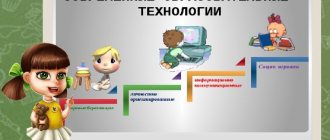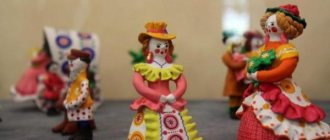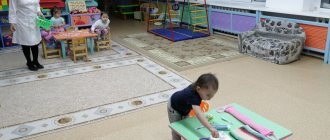Formation of communication abilities in preschool age
Speech is a universal means of communication that helps convey feelings, knowledge, and wishes. Without words, it is difficult to ask for something or communicate your intentions.
However, children, due to their limited age capabilities, are just beginning to master such an important tool.
From the first years of life, a child is focused on communication. He is friendly, smiling, and willing to make contact. But, if until the age of three the baby tries to interact with others, holding on to his mother or father’s hand, then in preschool age he increasingly has to do without the direct support of an adult.
By communicating with each other, children develop and gain new experiences. Some of them are proactive and take a leading position in the game. Others are responding to this initiative and adopting the proposed rules. Still others are observant and adopt those forms of communication that appeal to them.
The development of children's communicative culture is facilitated by the help of educators and parents. Adults support, suggest what is best to do, and also help develop the ability to demonstrate important elements of communication that form the basis of emotional intelligence:
- Sympathy and empathy;
- The ability to imagine what another feels;
- Containing emotions (without screaming, crying and stamping your feet);
- Understanding that each person is individual and may feel differently.
Nonverbal stage of communication
Nonverbal communication is conversation without the use of speech. This form of contact is available at any age. Developmental researchers say that children are capable of perfectly imitating the facial expressions of adults, and are not yet constrained by conventions and norms.
This skill is especially important for establishing contact with peers. In early preschool age, it is quite difficult to get acquainted and come to an agreement with the help of speech, but improvised means come to the rescue.
Playing nearby in the sandbox, a preschooler smiles and invites his new friend to make Easter cakes together. Confirming this proposal is very simple - hold out a spatula or mold. It’s also common for kids to want to show what they can do. Attention is more often attracted by touch, and the sand castle is shown using the hands.
At this stage, it is also easier for preschoolers to express sympathy and antipathy non-verbally. Those they love get hugs and kisses. Adults and children who do not enjoy the baby’s favor may see a frown on their forehead, the child’s back, or even an attempt to hide behind their mother’s skirt.
Communicative-speech stage
As the vocabulary is filled, the development of communication abilities in preschoolers accelerates. Questions arise: “Where?”, “Where?”. The baby adds simple explanations to non-verbal signals inviting communication: “My car,” “Pour sand into the bucket.”
At 4 years old, a child can easily make narrative sentences. Communicating with other children, the preschooler discovers his involvement in the community and joyfully states: “We roll cars,” “We run.”
Five-year-old children are able to invite a peer to play and actively use more complex constructions: “Let’s play shop, I’ll sell, and you’ll buy.”
In the communication of younger preschoolers, there are also conflict situations. For the most part, they are provoked by children's egocentrism. Sometimes a child will never agree to give his toy. On the other hand, there are children who, when they see an attractive car or scoop from another child, want to get it immediately.
In any of these cases, it is important that the adult explains to the child how to ask a friend to share a toy. It is necessary to teach little communicators the accepted polite phrases that regulate communication.
From the age of five, a preschooler, thanks to the development of coherent speech and awareness of the importance of words for communication, moves to a higher level of communication. Communication skills at this stage become especially important.
Formation of a communicative culture and socialization of a preschooler’s personality through gaming technologies
Korotkova Svetlana
Formation of a communicative culture and socialization of a preschooler’s personality through gaming technologies
Formation of a communicative culture and socialization of a preschooler’s personality through gaming technologies
I suggest you understand the terminology of this topic.
The formation of a communicative culture and socialization of the individual includes the assimilation of norms and values accepted in society, the development of communication and interaction of the child with adults and peers; development of emotional responsiveness, empathy, formation of readiness for joint activities with peers.
Preschool age is the period of a child’s initiation into cognition
the surrounding world, the period of his initial socialization .
During these years, the child acquires initial knowledge about the life around him, he begins to form a certain attitude towards people, towards work, develops skills and habits of correct behavior, and develops a character. This explains the enormous educational potential of play, which psychologists consider the leading activity of a preschooler .
Play is joy, learning, and creativity. This is what a child goes to kindergarten for.
The right to play is enshrined in the Convention on the Rights of the Child (Article 31)
.
In the Federal State General Educational Standards for Preschool Education, play is considered an important means of socializing the personality of a preschooler .
In the context of the introduction of the Federal State Educational Standard for Education, it is important for teachers to understand: what are gaming technologies , how to use them in the educational process?
With the introduction of the Federal State Educational Standard for Preschool Education, we were faced with the following tasks aimed at introducing gaming technologies into preschool educational institutions :
• The need to explain to parents the importance of the game
• Providing a safe space for play
• The presence of an appropriate developmental subject-spatial environment that supports the game
• Children's free time should not be strictly programmed. The teacher must observe children, understand their play plans and experiences.
The purpose of gaming technology is not to change or remake the child, not to teach him any special behavioral skills, but to give him the opportunity to “live”
in the game, situations that excite him with the full attention and empathy of an adult.
The value of gaming technology is not that it is entertainment and relaxation, but that with the right guidance it becomes: a way of learning; activities for the realization of creativity; method of therapy; the first step in the socialization of a child in society .
Gaming technologies give the child the opportunity to “try on”
assume the most important
social roles ; be personally involved in the phenomenon being studied (motivation is focused on satisfying cognitive interests and the joy of creativity); live for some time in “real life conditions”
.
If we look at the functions of the game, then in addition to entertainment, game therapy , diagnostic and others, it is communicative (mastering the dialectics of communication)
Game features:
- entertaining (to entertain, inspire, arouse interest)
;
— communicative (mastering the dialectics of communication,
— game therapy (overcoming various difficulties that arise in other types of life);
— diagnostic (identification of deviations from normal behavior, self-knowledge during the game);
— corrections (introducing positive changes to the structure of personal indicators );
— interethnic communication of social and cultural values for all people );
— socialization (inclusion in the system of social relations, assimilation of the norms of human society)
There are three classes of games (according to S. L. Novoselova)
:
• games initiated by the child (ren)
: experimental games (games with natural objects, games with animals, independent plot games (role-playing, director's, plot-displaying, theatrical);
• games that arise on the initiative of an adult who introduces them for educational and educational purposes: educational games (didactic, active, leisure games (fun games, entertainment games, festive carnival, intellectual, computer);
• games coming from the historically established traditions of the ethnic group: traditional or folk (family, seasonal, religious , games, etc.)
GAMING TECHNOLOGY INCLUDES:
• Story-based role-playing games
• Director's acting
• Theatrical games
Role-playing games.
Role-playing game is one of the creative games. In role-playing games, children take on certain functions of adults and, in specially created conditions, model the activities of adults and the relationships between them. Children's independence in role-playing games is one of their characteristic features. Children themselves determine the theme of the game, decide how they will reveal the roles, where the game will unfold.
The main component of a role-playing game is the plot, which is the child’s reflection of certain actions, events, relationships from the life and activities of others.
The plots of the games are varied. Conventionally, they are distinguished:
• Household ( “Family”
,
"Kindergarten"
)
• Industrial ( “Hospital”
,
"Shop"
, "Hairdresser)
• Public ( “Birthday”
,
“Library”
,
“School”
Story-based role-playing games carry a large social load . The main rule for organizing such games is “more participants, fewer fans.” These games have some kind of plot, i.e. a plot, climax , denouement.
Organization of role-playing games in the younger group.
The kids were brought to kindergarten, how different they are, how different they are from each other. 25 kids with different characters came to the group: silent, talkative, fighters and bullies. For most children, the kindergarten group is the first children's society where they acquire initial skills in collective relationships. We must teach the child to live by common interests, obey the demands of the majority, and show kindness to peers. Therefore, I set myself the task of cultivating this feeling in children from the first days of their stay in kindergarten and decided to use role-playing games for this purpose. From my first observations of games, I found out how children express themselves in them. I set myself the following tasks: to teach a child to play, to help unite children in play; tactfully guide the choice of games, teach children to follow the rules during the game, cultivate a sense of goodwill and mutual assistance. Work on the development of role-playing games was carried out in two directions:
1. Creating the necessary gaming environment
2. Direct supervision of children's games.
"Family"
To create a cozy home environment, we have equipped a gaming environment . Beautiful elegant dolls, furniture, various dishes, food quickly attracted the kids, and they began to do a variety of things with them: cook, go to visit, drink tea, put the children to bed, etc.
"Shop"
An adult starts the game, attracting children with an interesting plot.
Play area "shop"
is one of the most effective and multifunctional spaces for role-playing games.
It is in the “Shop”
in kindergarten that you can organize a variety of games in which children will learn the most important
social skills . The field for plots is the most extensive. Children can turn into a buyer, a seller, a product supplier, and a cashier. I bring to your attention a photo report “Shop”
play area .
"Salon"
Our hairdresser will give you a beautiful hairstyle!
"Hospital"
Game of "Hospital"
introduces children to certain rules in the clinic, pharmacy, and doctor’s office.
"Train"
,
“Orchestra”
“If you take the instruments, you can play together”
Playing in an orchestra instills in children active attention, perseverance, develops willpower, a sense of camaraderie, mutual assistance, and the ability to complete a task, i.e., qualities that are necessary for a future schoolchild.
In the younger group, I actively introduced children to musical instruments. They enjoyed playing the tambourine, drum, pipe, and bell that bears, bunnies, and squirrels brought them as a surprise.
"Chauffeurs"
,
"Builders"
,
"Motorcyclists"
,
"Rocket Flight"
At the beginning of the younger group, most children reproduced only object actions, many of them simply manipulated toys. My task was to direct the children to enrich play activities and develop the play plot . For this purpose, we observed with children the work of a nanny, a cook, a doctor, and organized targeted walks during which we paid attention to the labor actions of the driver and janitor. During the observation, I drew the kids’ attention to the fact that the cook had prepared a delicious breakfast, lunch, and dinner. I introduced the children to the names of dishes. Subsequently, while playing, the children did not just put pots on the stove, but “cooked”
soup, compote, etc.
At first, when some of the children did not know each other, they played alone and in quite a variety of ways. I tried to help them unite into a single team. By the end of the junior group, the children learned to play in small groups, and began to show attention and kindness to each other, and learned to give up toys to their comrades. There are fewer conflict situations. Matryoshka and Kolobok, Nyusha and Hedgehog helped us play together.
In the middle group, the game tasks became more complicated. In addition to the task of forming a communicative culture and socializing the individual, the following tasks were added: to encourage and develop children’s initiative in choosing a game, to develop its concept, to develop and support it with positive content.
"Firefighters"
"Road ABC"
In the middle group game actions become more complicated, we get to know pedestrians, passengers, traffic police inspectors, zebras, etc. New attributes are introduced: pedestrian crossing, traffic lights with changeable lights, driver's license, road signs.
"Sailors"
Together with the children we prepare for the game: we build a ship, distribute roles, distribute attributes (for the captain - binoculars, for the sailors - caps, for the doctor - a suitcase with tools, for the cook - a stove with food, for the radio operator - headphones.
Gaming technologies include theatrical games.
The actors are the children themselves, who take on the roles of literary fairy-tale characters. Children do not invent the plots of such games themselves, but borrow them from fairy tales, stories, and cartoons. The child’s creativity in theatrical play is manifested in a truthful portrayal of the character
In contrast to role-playing games, where the child is free to convey the image of role-playing behavior
The theme and content of the theatrical play has a moral orientation, which is contained in every fairy tale and literary work and should find a place in improvised productions. This is friendship, responsiveness, kindness, honesty, courage. The characters become role models. The child begins to identify himself with his favorite image. The ability to such identification allows one to influence children through With pleasure, transforming into a favorite image, the baby voluntarily accepts and appropriates his characteristic features. Independent role-playing by children allows them to develop the experience of moral behavior and the ability to act in accordance with moral standards. Because positive qualities are rewarded and negative ones are frowned upon, children generally want to emulate kind, honest characters. And adults’ approval of worthy actions creates in them a feeling of satisfaction, which serves as an incentive to further control their behavior.
In the younger group, children happily transformed into dogs, cats and other familiar animals, but they were not yet able to develop and play out the plot. We played the games “Hen and Chicks”
,
“Cat and Kittens”
,
“Hare and Little Bunnies”
, acted out small scenes from children’s life, organized games based on literary works:
“Toys”
by A. Barto,
In the middle group, they already learned to combine movement and words in roles, and used exercises like “Imagine yourself as a little bunny and tell us about yourself.”
.
Fairy tale "Spikelet"
A group of children dramatized the fairy tale “Spikelet”
using puppet theater. We teach children hard work and talk about how bread is made. But the educational task that confronted us was related to the development of skills for interacting with each other during the performance, team unity, and achieving mutual understanding.
There are 6 characters in the tale.
Involving inactive children in games, we dramatized the nursery rhyme “Little Little Kitty”
, in which a small number of actions
Director's play
a special place in the formation of a communicative culture and the socialization of a child’s personality to director’s play. In a child's life, director's play arose earlier than plot-role play. The peculiarity of the director's game is that the partners are inanimate objects, substitute toys. These toys become the protagonists of the child’s play, and he himself acts as a director, managing and directing the actions of his “actors.”
In this regard, games with interactive toys are very interesting - singing animals, interactive cats (with sound, voice, eye lighting, repeat toys, Baby Bon dolls that can eat porridge, blink, react to touch, have chickenpox, Furby toys, etc. .
They interest several children with their unusual capabilities, uniting them in one game.
Interactive fairy tales
“Fairy tale scenarios for interactive activities with children” helps us a lot in our work.
. 2014 The book presents tales of five main groups:
1. Educational tales ( “How the hare cooked compote”
,
“About the cockerel who couldn’t sing”
,
“How the little bear lost his tail”
)
2. Fairy tales that help raise children. ( "Dirty Pig"
,
“
Good friends”,
“
How to help your mother”)
3. Literary fairy tales ( "Spikelet"
, “Fox with a rolling pin, etc.)
4. Fairy tales with open endings
5. Fairy tales that we show with our fingers.
In interactive fairy tales, each child plays a certain role, his own hero, and at the same time works in a team, creating together a single whole.
The scenarios that the authors offer are simple, do not contain a large number of lines, are easily remembered and reproduced by children. In addition, they are remarkable because an unlimited number of artists take part in each performance. The number of artists can be added or reduced if necessary. There is also no need to prepare complex decorations; any performance can be organized within 10 minutes.
All that is required is to hand out dolls or soft toys that represent the characters, explain what line the child should say, and with the right intonation.
Speaking in front of an audience, the child becomes more confident in himself, solves many psychological problems for himself: overcomes shyness, plays out the solution to certain situations that are likely to arise in life.
Gaming communication technologies.
The purpose of communicative games of a group nature is to unite the team; intragroup interaction, relieving emotional stress, developing cooperation skills.
We bring to your attention a block of communicative games aimed at group unity and effective intra-group interaction, of course, at an older age.
Collective fairy tale (one of the children starts a fairy tale or some story, and each one after him adds)
"I love my neighbors"
(Children sit in a circle; the presenter is in
. The players stand up and change places. The presenter tries to take a seat.
“Voice techniques "
1.
Laughter technique .
When one person starts laughing, others join in, and eventually everyone starts laughing. 2. Humming technique As in paragraph . 1., only everyone is buzzing.
"Rhythm in a circle"
The child sets the rhythm by clapping, and the group picks up the given ri.
The group is divided into several teams.
The team selects different instruments and a playing conductor. After preparation, one of the teams imitates the melody, and the rest guess. "Bees and Snakes"
Children are divided into 2 groups: bees and snakes.
Each group chooses its own king. Both kings leave the room and wait to be called. During their absence, the teacher hides 2 objects (for example, a sponge - this will be honey, and a pencil - this will be a lizard)
. The kings must find their items, and the teams must help them by making certain sounds. All bees should buzz and snakes should hiss. The closer the king bee gets to the honey, the louder the buzzing should be. Accordingly, snakes hiss louder.
"Cows, cats, dogs"
Presenter to the children: “I will whisper in each of you the name of an animal in your ear.
Remember it, because later you will need to depict this animal. When all the children are distributed, you need, without opening your eyes, to unite in groups with all those animals that “speak”
the same as you. You can move around the room and, hearing your animal, move towards it, hold hands with it and move around together.
"Tender Paws"
An adult selects 6-7 small objects
of different textures : a piece of fur, a brush, a glass bottle, beads, cotton wool, etc. The child is asked to bare his arm up to the elbow, the teacher explains that an “animal”
and touch it with its affectionate paws.
You need to guess with your eyes closed which “animal”
touched your hand - guess the object.
The “animal”
can touch the cheek, knee, palm.
"Shouters-whispers-silents"
You need to make 3 silhouettes of a palm from multi-colored cardboard: red, yellow, blue.
These are signals. When an adult raises a red palm - “whisper”
- you can move quietly and whisper, when the signal
is “shout”
- a blue palm - children scream, when the signal is
“silent”
- a yellow palm - children should freeze in place or lie on the floor and not move.
The game should end with silence
.
"Let's say hello"
Children, at the leader’s signal, begin to move chaotically around the group and greet everyone who meets on their way. They must greet each other in a certain way: one clap - we shake hands; two claps - we greet with hangers; three claps - we shake our backs. To ensure complete tactile sensations, it is advisable to introduce a ban on talking during this game.
"Naughty"
An adult, at a signal
(clap, hit a tambourine, ring a bell, etc.),
invites the children to play pranks: run, jump, tumble. At the leader's signal, the pranks must stop.
"Centipede"
Participants in a group game stand one after another, holding the waist of the person in front.
At the teacher’s command, the “centipede”
begins to move forward, crouches, jumps on its right and left legs, crawls between obstacles, etc. The main task of the participants is not to break the chain and save the centipede.
"Floor, nose, ceiling"
(
“Dwarves and Giants”
) The teacher names the words
“floor”
,
“nose”
,
“ceiling”,
shows with his index finger where they are, and the children repeat.
The teacher sometimes “makes a mistake
,” and the one who repeats
the “mistake”
is eliminated.
“The Fun Engine”
Players stand one after another. The first in the chain is a steam locomotive. His eyes are open. All other players – the “carriages”
– have their eyes closed.
The locomotive carries its train straight, snake-like, and with obstacles. The task of the “carriages”
is to follow
the “locomotive”
forward without releasing their hands.
The task of the “locomotive”
is to walk in such a way as not to lose the trailers behind you.
If the “car”
is unhooked, then the train
is “repaired”
and moves on.
"A swan was flying..."
(Game option:
“The dragons were flying and eating donuts. How many donuts did the dragons eat?”
or
“Once upon a time there was a dwarf, his name was Tom. He could count to ..."
)
"Broken Phone"
CONCLUSION:
Thus, gaming technologies are closely related to all aspects of the educational work of a kindergarten and the solution of its main tasks.
Using gaming technologies in the educational process, an adult needs to have empathy, goodwill, be able to provide emotional support, create a joyful environment, encourage any invention and fantasy of the child. Only in this case will the game be useful for the development of the child and the creation of a positive atmosphere of cooperation with adults.
Compiling gaming technologies from individual games and elements is the concern of every educator.
Learning in the form of a game can and should be interesting, entertaining, but not entertaining. To implement this approach, it is necessary that educational technologies developed for teaching preschoolers contain a clearly defined and step-by-step described system of game tasks and various games so that , using this system, the teacher can be confident that as a result he will receive a guaranteed level of learning a child of one or another subject content. Of course, this level of the child’s achievements must be diagnosed, and the technology must provide this diagnosis with appropriate materials.
In activities with the help of gaming technologies, children develop mental processes.
Gaming technologies are closely related to all aspects of the educational work of a kindergarten and the solution of its main tasks. Some modern educational programs propose using folk games as a means of pedagogical correction of children's behavior.
Thus, gaming technologies are closely related to all aspects of the educational work of a kindergarten and the solution of its main tasks. However, there is an aspect of their use that is aimed at improving the quality of the pedagogical process by solving situational problems that arise during its implementation. Thanks to this, gaming technologies turn out to be one of the mechanisms for regulating the quality of education in kindergarten: they can be used to level out negative factors that influence the decrease in its effectiveness. For example, there is no need for proof that in our time it is more difficult to work with children than even 5-6 years ago, since the number of children with various of gaming technology helps to cope with this - play therapy . If a child is understood and accepted, he can more easily overcome his internal conflicts, and the opportunities for his personal growth . This is the main point of play therapy . The goal of play therapy is not to change the child or remake him, not to teach him any special behavioral skills, but to give him the opportunity to “live” situations that excite him in the game with the full attention and empathy of an adult.
Development of communication abilities of older preschoolers
A child who prefers to spend time alone often does so for reasons of inability to be interesting and communicate well. Being among his peers, he may experience shyness, lack of self-confidence, or be aggressive. Therefore, preschool development requires the allocation of a significant amount of time for the formation of communication skills.
The conditions for the development of communication abilities imply two complementary paths. The first is active communication with adults and adopting their communication model and style of communicative behavior. The second is spending time with peers, during which children constantly learn from each other.
With the development of communicative abilities, children of senior preschool age develop stable motives for communication and a desire to interact with both adults and peers.
Borrowing adult communication models
By communicating with adults, a preschooler develops the basic components of communication skills. The ready-made model that they observe among relatives and educators allows them to understand the following:
- When to make contact, that is, to understand under what conditions conversations are appropriate and when to remain silent;
- How to organize communication, how to resolve conflicts, clearly see emotional empathy;
- What norms and rules does communication require, that is, to determine for yourself the boundaries of acceptable harshness, frankness, and playfulness.
Also, dialogues with adults mean obtaining information about knowledge and cultural values. By example, children learn to tell stories, learn how to make their stories interesting and exciting.
Development of abilities in communicating with children
The fundamental difference between communication with peers is increased emotional intensity. In this case, boundaries are removed, and children learn to be sincere and artistic. Their communication includes causeless laughter, antics, loud statements that turn into screaming.
In this way, children experiment, independently looking for ways to attract attention to themselves without the help of adults.
Also in peer communication there may be elements such as:
- Unpredictable combinations of syllables and sounds - attempts to create your own language;
- Lack of rules;
- Having harsh words to help release emotions.
If, when talking with adults, a preschooler asks and listens more, then in conversations with peers he strives to speak out himself, even if this means shouting down others. Moreover, the preschooler expects evaluation or new information from teachers and parents. Just by chatting with friends, he learns to express himself and emotions, express desires, show his mood through words, and even tries to take on leadership functions, demonstrating initiative and trying to manage the rest of the company.






